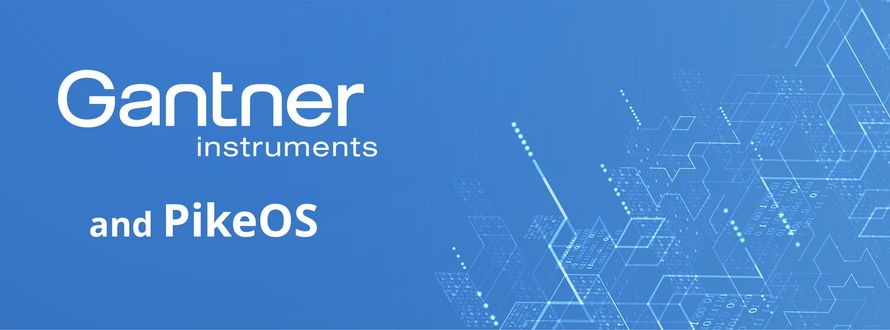The e.gate E101 Measurement Controller
The measuring system from Gantner Instruments consists of the measuring amplifiers of the e.bloxx 100 series. This is a family of modules that precisely and quickly digitise analogue measured values and transmit them via serial interface. On the analogue side, the AD conversion can be done with up to 400kHz at 20bit. The resolution is automatically increased by downstream averaging.
The serial interface is of the RS-485 type and is therefore very robust and easy to install or subsequently expand. The data transfer rate is 48Mbps and, due to the increased efficiency, delivers data rates that correspond to a 100MB Ethernet interface. The modules of the e.bloxx 100 series are available in different designs: As DIN rail modules, as 19''-3U slide-in cassettes, as 19''-1U racks or as robust IP67 boxes.
Up to 128 arbitrary measurement modules can be connected to a higher-level test controller via up to four UARTS. The distance between modules and controller can be up to 50m.
Communication
The controllers are slaves for the automation system and the application system, and masters for the e.bloxx modules. The connection to the automation system is an EtherCAT connection with 100Mbps and corresponds in all details to the specifications of the ETG (incl. CoE).
The interface to the application system is a 1 GigE and allows the transport of blocked data. TCP/IP, FTP, UDP serve as protocols. The controller can work here either as a client or server. The transferable data volume is approx. 15MB/sec (32 measured values in float with 100kHz each incl. time stamp) per controller. A total of approx. 50MB/sec. can be transferred.
Since the e.gate E101 controllers work both as a web server and as an FTP client or server, they can be integrated very flexibly into higher-level automation systems.
In addition to these Ethernet interfaces, the controller has a CANOpen interface. The CANOpen slave and EtherCAT interfaces are implemented as hardware communication modules within the controller and can very easily be exchanged for other communication modules. Thus, at a later date, the system can be adapted to new communication standards at any time.
Synchronization
All connected e.bloxx modules are synchronised from the controller, the controller itself is synchronised via the EtherCAT master or an external system and can in turn synchronise other external participants. In this way, a cross-system jitter < 2 µs can be guaranteed. Optionally, GPS/DCF77 modules can be connected to the controllers, whereby synchronisation can also take place independently of the AUSY master.
Data Logging
The controller has a fast internal RAM memory of 512MB, which can be expanded to 1GB. This allows fast measurement data recordings to be buffered and then transferred in a block transfer. External storage media such as memory sticks or hard disks can be connected via USB. All stored data can optionally be provided with a time stamp or, in "aggregate mode", with angle information.
Configuration
Each individual e.bloxx contains its complete configuration data in an ASCII file. This data is stored in the module and mirrored in the DIN connection block. By plugging in a TEDS-compatible sensor, various parameters are overwritten and thus the module is adapted to the new sensor.
On request, this data is transmitted to the higher-level controller. The controller converts the ASCII data into an XML file for each connected module and generates various "collective files" from this data that reflect the entire configuration of a controller. In this way, dynamic configuration data can be created for the respective automation masters - e.g. for the bottom-up configuration of the EtherCAT master.
The controller can be accessed directly via FTP as well as via WEB access. Each individual parameter of a measuring module is available here for read and write access. Who is allowed to read and write which data can be defined via multi-level hierarchies.
Since only industry standards are used for communication, it is not necessary to use Gantner software. Thus, configuration can already be done directly from Morphee, among other things.
SYSGO's Solution for Ganther
The challenge was to choose a partitioned operating system as commercial-off-the-shelf (COTS) platform for the combination of hard real-time and Linux. SYSGO's solution was to replace former real-time operating system by the PikeOS virtualization platform and separate the POSIX based I/O data acquisition and Linux-based network into different partitions.
By using the PikeOS virtualization platform, Gantner was able to satisfy tight real-time requirements on one hand and benefit from a feature-rich Linux at the same time. Furthermore, for a next generation test bed, Gantner reused legacy code on top of a PikeOS POSIX API making the application software standard-based and future-proof.
„We at Gantner Instruments choose PikeOS for two deciding reasons: In the first place because of outstanding partition capabilities of the operating system, that clearly separates own parts from applications; in the second place because of persuasive real-time response based on very fast interrupt handling“, sais Werner Ganahl, Chief Exexcutive at Gantner Instruments Test Measurements GmbH.
More information at www.sysgo.com/pikeos
About Gantner Instruments
Gantner Instruments GmbH, based in Schruns/Austria and Darmstadt/Germany, has been involved in decentralised data acquisition since its foundation in 1982. Together with our partner - the company D2T - we supply international automotive companies and their suppliers with data acquisition systems for engine, climate and component test benches. To date, about 65,000 Gantner measurement modules are in use. The MTBF (Mean Time Between Failures) calculated from the repair statistics is >40 years.
www.gantner-instruments.com

